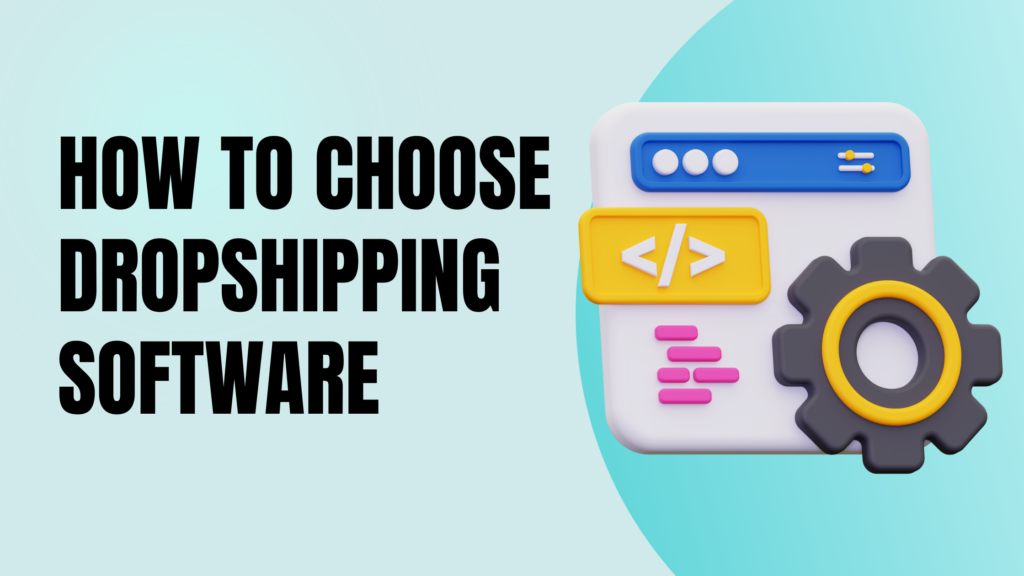How to Choose Dropshipping Software
Are you looking to start or switch your dropshipping business? One of the most crucial factors for success in dropshipping is choosing the right software. Before we dive into the specifics of choosing dropship software, let’s first understand what it is. Dropship software is an essential tool for online businesses that use a hands-off form of order fulfillment known as distributed order management. Unlike dropship aggregator apps and retail arbitrage tools, which act as middlemen between suppliers and resellers, dropship software enables sellers to partner directly with suppliers or manufacturers. When a sale is made, the seller forwards the order information to the supplier, who then fulfills the order. The seller pays the wholesale cost of the goods and keeps the profits.
Why Use Dropship Software?
Implementing dropship software infused with automation technology can significantly improve the efficiency of your dropshipping business. By automating repetitive tasks, you’ll save time and increase productivity. But that’s not all. Here are some key reasons why you should consider using dropship software:
- Price and stock automation: The software optimizes product prices and automatically calculates profit margins, eliminating the need for manual work.
- Inventory management: While you don’t physically store your products as a dropshipper, you need to ensure inventory levels are maintained to avoid stock-outs. Dropship software helps you track and manage inventory across multiple suppliers and warehouses.
- Competitor monitoring: Keeping an eye on your competitors’ products and prices is crucial for staying competitive. Dropship software provides the tools to monitor and analyze your competitors’ offerings.
- Integration with multiple platforms: By integrating with various platforms and marketplaces, dropship software enables you to efficiently manage orders from different channels, resulting in increased customer satisfaction and revenue.
To truly excel, dropship software should not only facilitate dropshipping but also orchestrate orders to internal and external warehouses, as well as brick-and-mortar stores. It should seamlessly integrate with various systems, allowing for efficient order routing and management.
The Evolution of the Ecommerce Software Ecosystem
In the past, traditional retail businesses relied on a single warehouse and either a brick-and-mortar or online store. They typically used an Enterprise Resource Planning (ERP) system to manage their warehouse operations. However, as ecommerce and multi-channel retail became increasingly popular, the software ecosystem evolved to meet the growing demands of retailers. Here’s a breakdown of the key developments:
- Multi-Channel Retail: With the rise of multi-channel selling, retailers began listing their products on various online marketplaces in addition to their own online stores. To support these new sales channels, software solutions started to break away from all-in-one ERPs and focus on specific functionalities.
- Specialized Software: Open APIs and proprietary systems paved the way for specialized software solutions. Warehouse Management Systems (WMS) emerged to handle tasks such as barcode scanning, warehouse optimization, and pick-and-pack management. Shipping managers were introduced to handle carrier rate shipping, label printing, and shipping rate negotiations.
- Order and Listing Management Software: To manage inventory across multiple channels effectively, order and listing management software was developed. These tools allowed retailers to synchronize inventory and track sales across various channels.
- Distributed Order Management (DOM): DOM solutions streamline order fulfillment by connecting the entire supply chain. Dropship software, a part of DOM, allows sellers to send orders to different places like warehouses, stores, and dropship suppliers. DOM systems automate key tasks like order handling, shipping, forecasting, reordering, and inventory management.
As the ecommerce software ecosystem continues to evolve, it’s essential to choose a dropship software platform that aligns with your business objectives and can adapt to your specific needs.
Evaluating Dropship Software Platforms
Before selecting a dropship software platform, it’s crucial to define your business’s objectives and priorities. Involve all departments in your organization and communicate with your suppliers to ensure everyone is on the same page. Once you have a clear understanding of your requirements, you can ask the following questions to evaluate dropship software platforms:
1. Vendor Onboarding
 Efficient vendor onboarding is essential for seamless integration with your dropship software. Consider the following questions when evaluating a platform’s vendor onboarding capabilities:
Efficient vendor onboarding is essential for seamless integration with your dropship software. Consider the following questions when evaluating a platform’s vendor onboarding capabilities:
- What vendor onboarding solutions does the software offer?
- Can the platform easily sync product data through a CSV parser?
- Is there a limit on the number of vendors you can add? Are there additional fees for adding vendors?
- Can vendors log in to the software to access order information and print shipping labels?
- Does the software support EDI/API integration, and if so, what are the associated fees?
- Will you receive account manager assistance when adding multiple vendors?
2. Available Source Integrations
Integration with your suppliers’ inventory feeds and order fulfillment processes is crucial in dropshipping. Consider the following questions regarding available source integrations:
- Can the software send orders to multiple channels, including internal warehouses, 3PL warehouses, brick-and-mortar POS systems, and dropship suppliers?
- Does the platform support integration with both vendors and warehouses?
- Does the platform offer pre-built connections, or do you have to pay for each integration?
- Can you access a list of suppliers already integrated with the platform?
- Does the platform support API integration for custom integrations?
3. Available Channel Integrations
In addition to source integrations, it’s essential to consider the platform’s available channel integrations. Ask the following questions to understand their channel integration capabilities:
- Which online store platforms does the software support?
- Does the platform provide pre-built connectors for popular channels?
- Can you integrate with custom EDI/API integrations for specific channels?
4. Inventory Syncing
Accurate inventory syncing is crucial for successful dropshipping. Consider the following questions when evaluating a platform’s inventory syncing capabilities:
- How often can you sync inventory? Does the platform offer customization options for syncing frequency?
- Does the software update all relevant information during each sync, or does it use smart sync to optimize efficiency?
- Can you set up sophisticated rules to list the appropriate quantity of products for each channel?
5. Product Data and Listing Management
Managing product data and listings efficiently is essential, especially when dealing with a large number of SKUs. Consider the following questions when evaluating a platform’s product data and listing management capabilities:
- Can you easily import product data from data feeds?
- Does the platform support custom attributes and meta fields? How can you utilize and push this data to your channels?
- Can you use meta field data to filter products within the platform?
- Does the software support intelligent parent/child mapping, kitting, and bundling orders?
- Does the platform offer a built-in product repricer or integration with one?
6. Order Orchestration and Routing
Efficient order orchestration and routing can save you time and money. Consider the following questions when evaluating a platform’s order management capabilities:
- Can you build routing rules to optimize fulfillment based on factors such as location, cost, and warehouse preference? Can you customize these rules for different scenarios?
- Does the platform provide automation rules based on available data?
- Does the software support cross-docking and freight-forwarding capabilities?
- Can you access reports to reconcile orders with multiple purchase orders and ensure profitability across sources, products, and channels?
- Can the platform handle both wholesale and dropship orders?
7. Invoice and Accounting Management
Integrating with your accounting software is critical for streamlined operations. Consider the following questions when evaluating a platform’s invoice and accounting management capabilities:
- Can the software pull in supplier invoice data? How does this process work?
- Does the platform support PDF conversion capabilities?
- Which accounting platforms can you integrate with?
- Does the software automatically pull in channel tax and marketplace fees, or do you need to enter this information manually?
8. Returns and Refund Management
Efficient returns and refund management is crucial for maintaining customer satisfaction. Consider the following questions when evaluating a platform’s returns and refund management capabilities:
- How does the platform handle vendor returns and create shipping labels?
- Can you set up rules for returns within the platform?
- How does the software handle refunds and reconcile them with your accounting system?
9. Unique Model Needs
Depending on your specific business model, you may have unique needs that the dropship software should fulfill. Consider the following questions for specific business models:
B2B Membership Model:
- Can the platform automatically receive orders?
- Does the software auto-generate invoices with specific fees?
- What payment methods are accepted?
- How does the sign-up workflow for new resellers work?
Marketplace Vendor Network:
- How is channel pricing set? Is it automatically generated?
- What is the invoice and payment workflow?
- How does the platform handle vendor shipping and return labels?
By asking these questions and evaluating dropship software platforms based on their responses, you can make an informed decision that aligns with your business objectives and requirements.
Conclusion
Picking the right dropship software is crucial for your business success. Look at factors like vendor onboarding, inventory syncing, order handling, and more to find a platform that suits your needs. Define your goals, involve everyone, and ask the right questions during evaluation. The right dropship software streamlines operations, boosts efficiency, and elevates your dropshipping business.




